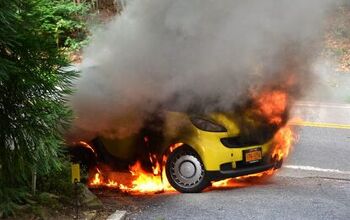Smart Summon a Smart Idea? The NHTSA Wants to Know

For some strange reason, U.S. road safety regulators are showing an interest in a Tesla feature that allows driverless vehicles to navigate tight, crowded public spaces on their own — one Tesla admits “may not detect all obstacles.”
Clearly, by investigating reports of Tesla’s Smart Summon feature going awry, the National Highway Traffic Safety Administration is standing in the way of progress, or so some brand diehards would have you believe. To others, the agency’s scrutiny is overdue.
The NHTSA announced it was poring into reports of Smart Summon fails on Wednesday evening, nearly a week after Tesla’s latest software update delivered the feature to owners who opted for the Full Self Driving package at purchase time.
While Tesla CEO Elon Musk claims owners used the feature over half a million times within a few days, it’s the less-successful parking lot forays that the NHTSA’s worried about.
Designed to be used as a valet service in private parking lots and driveways, Smart Summon navigates the Tesla at low speeds to the owner’s location, with the car using the owner’s phone as a homing beacon. Users are warned to use the feature when no more than 200 feet from the car, and only when the vehicle is within their line of sight. As we showed you Saturday, those early experiments were not without drama.
One Model 3 nearly collided with an Acura MDX in a crowded parking lot, only coming to a halt after the owner took his finger off the phone app’s summon button. Another hit a garage wall in a video uploaded by the owner, while one owner claims their Tesla made contact with a vehicle that was in the process of backing up. Yet another video showed a Tesla that was unable to differentiate asphalt from grass.
As reported by Reuters, the NHTSA claims it “is aware of reports related to Tesla’s Summon feature. We are in ongoing contact with the company and we continue to gather information. Safety is NHTSA’s top priority and the agency will not hesitate to act if it finds evidence of a safety-related defect.”
Tesla issued the feature with appropriate warnings about owner vigilance and proper use, but the mere fact the feature exists — and could fall into the hands of a not-so-vigilant owner — is legitimate cause for concern. Just because the automaker tells users to be “especially careful around quick moving people, bicycles and cars” does not mean people will. Were a collision to happen, there’d be no one behind the wheel. Who’s at fault — the user, or the company behind the self-driving parking lot denizen?
You can be sure lawyers are salivating at the thought of seeking a pound of flesh from Tesla.
[Image: Tesla]

More by Steph Willems
Latest Car Reviews
Read moreLatest Product Reviews
Read moreRecent Comments
- AZFelix UCHOTD (Used Corporate Headquarters of the Day):Loaded 1977 model with all the options including tinted glass windows, People [s]Mugger[/s] Mover stop, and a rotating restaurant. A/C blows cold and it has an aftermarket Muzak stereo system. Current company ran okay when it was parked here. Minor dents and scrapes but no known major structural or accident damage. Used for street track racing in the 80s and 90s. Needs some cosmetic work and atrium plants need weeding & watering – I have the tools and fertilizer but haven’t gotten around to doing the work myself. Rare one of a kind design. No trades or low ball offers – I know what I got.
- El scotto UH, more parking and a building that was designed for CAT 5 cable at the new place?
- Ajla Maybe drag radials? 🤔
- FreedMike Apparently this car, which doesn't comply to U.S. regs, is in Nogales, Mexico. What could possibly go wrong with this transaction?
- El scotto Under NAFTA II or the USMCA basically the US and Canada do all the designing, planning, and high tech work and high skilled work. Mexico does all the medium-skilled work.Your favorite vehicle that has an Assembled in Mexico label may actually cross the border several times. High tech stuff is installed in the US, medium tech stuff gets done in Mexico, then the vehicle goes back across the border for more high tech stuff the back to Mexico for some nuts n bolts stuff.All of the vehicle manufacturers pass parts and vehicles between factories and countries. It's thought out, it's planned, it's coordinated and they all do it.Northern Mexico consists of a few big towns controlled by a few families. Those families already have deals with Texan and American companies that can truck their products back and forth over the border. The Chinese are the last to show up at the party. They're getting the worst land, the worst factories, and the worst employees. All the good stuff and people have been taken care of in the above paragraph.Lastly, the Chinese will have to make their parts in Mexico or the US or Canada. If not, they have to pay tariffs. High tariffs. It's all for one and one for all under the USMCA.Now evil El Scotto is thinking of the fusion of Chinese and Mexican cuisine and some darn good beer.

































Comments
Join the conversation
Those videos look more like an Alpha test...that stuff isn't even Beta test level.
RE: The lede photo. Viewing the image of a dashboard without gauges, buttons, or dials prompts me to feel an involuntary nostalgic flashback to the days when cars were not mobile computer terminals.